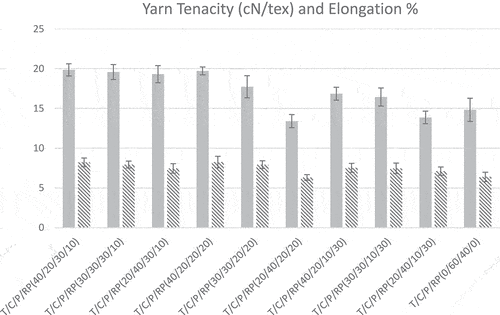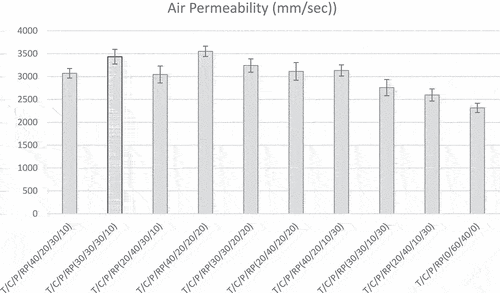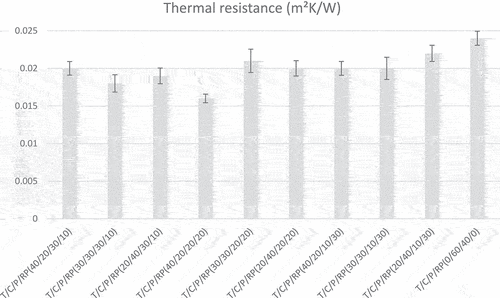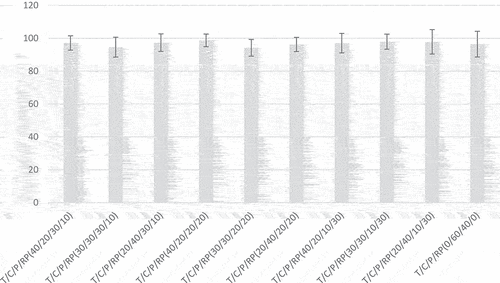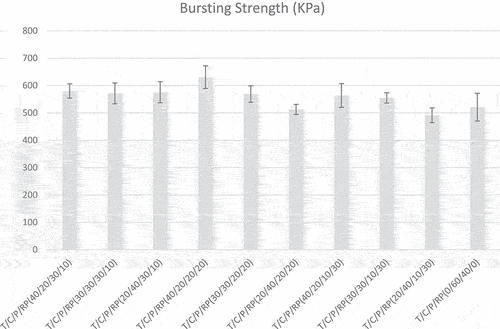ABSTRACT
In this work, 10 yarn samples were prepared through ring spinning with different ratios of Tencel, cotton, polyester, and recycled polyester fibers. These yarns were converted into knitted fabrics by a sample knitting machine, and their mechanical and comfort properties were investigated. The mechanical tests were comprised of bursting strength and pilling tests, whereas tests of comfort properties included air permeability, water vapor permeability, and thermal resistance. It is found that the fibers of Tencel/cotton and virgin polyester/recycled polyester with blended ratios of 40/20 and 20/20, respectively, give better mechanical and comfort properties than other blended ratios and the “chief value cotton” (CVC) (60:40) blend. CVC (60:40) is a conventional blend comprising 60% cotton and 40% virgin polyester that is being used for summer clothing. Therefore, by analyzing statistically and comparing different blends, it is established that Tencel/cotton and virgin polyester/recycled polyester with blended ratios of 40/20 and 20/20, respectively, not only offer better mechanical and comfort properties, but the consumption of unsustainable virgin polyester and cotton fibers can also be decreased by 60%.
摘要
在这项工作中,采用Tencel、棉、聚酯和再生聚酯纤维的不同比例,通过环锭纺纱制备了10个纱线样品.用样品针织机将这些纱线转化为针织物,并对其力学性能和舒适性进行了研究. 机械试验包括爆裂强度和起球试验,而舒适性包括透气性、水蒸气渗透性和耐热性. 研究发现,Tencel/棉和原始聚酯/再生聚酯纤维的混纺比分别为40/20和20/20,其机械性能和舒适性优于其他混纺比和“主要价值棉”CVC(60:40)混纺.CVC(60:40)是一种传统的混纺面料,由60%的棉和40%的原始聚酯纤维组成,用于夏季服装.因此,通过统计分析和比较不同的共混物,确定Tencel/棉和原聚酯/再生聚酯的共混比例分别为40/20和20/20,不仅提供了更好的机械性能和舒适性,而且不可持续的原聚酯和棉纤维的使用也可以减少60%.
Introduction
Wear comfort out of esthetic appearance, quality, cost, etc., has become one of the demanded factors for consumers choosing clothing. Clothing has an important role in maintaining body temperature as well as moisture uptake under different environment and body conditions in different activities. In thermo-physiological comfort, two parameters including moisture transmissions and thermal heat from body through fabric are very important for clothing comfort. There are different parameters (thermal conductivity and thermal resistance, air permeability, water vapor permeability, and wicking) that affect the thermo-physiological comfort. Also, different factors, for instance, the type of fiber, composition of fibers, yarn and fabric structural properties of yarns and their fabrics as well as different applied finishing considerably alter the thermo-physiological comfort properties of clothes.
The world production of textile fibers rose to approximately 111 million metric tons with major fibers being polyester (40.6%), cotton (24.1%), regenerated cellulosics (6.3%), other natural fibers (4.8%), and wool fibers (0.9%) (Citation2021). Virgin polyester (VPET) is the most used synthetic fiber. The use of renewable resources is always better for the environment. VPET fiber, cotton fiber, and their blends are major raw materials of textile industry globally. Furthermore, global textile clothing is using 40% cotton, whereas about 60% is VPET. Textiles made from VPET and cotton fibers have combined properties including strength, moisture management, crease recovery, comfort, and easy handling; however, the production of VPET–cotton fibers mainly affects the environment, leading to unsustainability.
The highly consumed fiber (over 50%) in textiles is VPET. It has exceptional properties, but it is not an eco-friendly fiber, and it diminishes fossil fuels and enhances the landfill sites. Likewise, cotton being a natural fiber requires an excess amount of water during its cultivation. Around 20,000 L of water is required for producing 1 kg of cotton fibers. Moreover, the consumption of insecticides and pesticides for cotton fibers are 24% and 11% of the total consumption of insecticides and pesticides, respectively (Muthu Citation2018). The requirement for such a huge amount of fresh water and insecticides and pesticides greatly affects the local environment. The genetically modified cotton can be used as an alternative; however, it has not significantly reduced the consumption of freshwater, insecticides, and pesticides.
Owing to lightweight, low cost, resistance to germs, and lightness, bottle grade polyester called recycled polyester (RPET) is commonly used for water and beverage packaging. Water bottles, soft drinks, and other liquids account for 83–84% of the global PET resin demand. Furthermore, by 2025, the predicted demand for PET packaging materials is expected to exceed 27.13 million tons during 2020–2025 with an average increase of 3.7% annual rise (Patt Citation0000). Plastic bottles are used and discarded for a variety of reasons on a regular basis. Owing to contamination, these plastic bottles cannot be reused after recycling. These, on the other hand, can be used as textile raw materials. RPET fiber is a recycled textile fiber made from plastic bottles. In textiles, RPET fiber has been employed for a variety of reasons. RPET does not pose a serious threat to the environment because its production emits less CO2. This polyester also reduces the waste of petroleum fuels, which is a main component in the manufacturing of polyesters, as well as the overall carbon footprint of the polyester industry (Kumar and Janet Joshiba Citation2020; Radhakrishnan et al. Citation2020).
Lyocell is a biodegradable fiber that is regenerated from wood pulp using a green process. It has improved properties than cotton regarding moisture absorbency and spreading. Also, it has enhanced wet and dry tensile strength than cotton. Moreover, its blending with other fibers is quite simple. In addition, the problem of its fibrillation can be reduced by applying a suitable cross linker prior to the dyeing process.
Nowadays, research work is being conducted to produce sustainable textiles from Tencel fibers and RPET fibers. Jabbar et al. (Citation2020) produced knitted fabrics using sustainable Lyocell and polylactic acid fibers. Similarly, Basit et al. (Citation2018, Citation2019) used Lyocell fibers to produce sustainable fabrics (Latif et al. Citation2018, Citation2019). Moreover, to produce sustainable fabrics, there are some other studies in which the Lyocell fibers were blended with other fibers (Badr, Hassanin, and Moursey Citation2016; Govindan et al. Citation2016; Karthikeyan et al. Citation2017). There are few research studies in which RPET fibers were used in yarn and fabric production. Uyanık (Citation2019) produced different yarns using RPET and established that RPET fiber is more appropriate for thick yarns, i.e. Ne 10 and Ne 20 as pure and in all blend ratios, whereas it is suitable in blends in 65% for Ne 30 and 35% for Ne 40 yarns. Similarly, in another study, it was concluded that the use of RPET fiber is more suitable for coarse yarns and the knitted fabrics containing these yarns, and it is not definitely proper for the knitted fabrics having Ne 40 yarns (Seval Citation2020). Telli and Özdil (Citation2015) produced the blends of RPET fibers with cotton and VPET. They have concluded that RPET fibers give inferior properties than VPET; however, these can be added with VPET in certain amounts without noticeable changes. Similarly, when blended with cotton, it gives improved properties compared to 100% cotton (Telli and Özdil Citation2015). Yuksekkaya et al. produced knitted fabrics from virgin cotton and VPET and, recycled cotton and RPET fibers. They found that fabrics made from RPET fibers give inferior mechanical properties (Yuksekkaya et al. Citation2016). Similarly, in another study, it is found that fabrics made from RPET fibers give inferior mechanical properties than VPET fibers (Sarıoğlu Citation2019).
In the current study, it is studied that sustainable fibers can be used to replace unsustainable fibers to get better quality of yarns and fabrics. For this purpose, the sustainable fibers Tencel (regenerated) and RPET (recycled) fibers have been blended with unsustainable cotton and VPET fibers to produce tetra blended yarns. Tencel and RPET fibers have been used to replace cotton and VPET, respectively. These blends have also been compared with the conventional blend CVC (60:40), which is famous for summer clothing. It is found that it is possible to reduce the consumption of unsustainable cotton and PET fibers by Tencel and RPET fibers, respectively. The blended yarns and fabrics of Tencel and RPET fibers not only reduce the use of cotton and VPET fibers but give better properties than CVC (60:40).
Materials and methods
Materials
Cotton, VPET, Tencel, and RPET fibers were used in the current study. The properties of different fibers are given in .
Table 1. Polyester fiber specifications.
Methods
Ten yarn samples having a linear density of 20 Tex were produced, with different blending ratios as given in . The yarns were produced through conventional ring spinning line. The details of machines used in this work are given in .
Table 2. Blend ratios of different yarns.
Table 3. Equipment of yarn manufacturing.
Knitted fabric samples with different yarns were produced on a sample knitting machine of Koike Japan (1992) with a cylinder diameter of 4 inches, one feeder, and 210 needles.
Testing
The details of the testing conducted in this work are given in .
Table 4. Details of the testing conducted.
Results and discussion
Yarn properties
The different yarn properties obtained from typical load–elongation are plotted in . The inherent properties of the fibers are a key factor affecting the strength of the subsequent yarn. It can be perceived that tenacity is higher for the yarns with a larger share of Tencel and a smaller ratio of cotton fibers. This is due to the fact that Tencel is a biodegradable absorbent with higher dry and wet (containing 85% of dry) tensile strength than cotton. Similarly, as the ratio of VPET fiber decreases and the ratio of RPET fiber increases, the strength of the yarn also decreases as VPET fiber offers a higher strength than RPET fiber. Comparing to CVC (60:40) yarn, it is realized that all yarns impart higher strength than CVC (60:40) yarn; however, the yarns having a higher ratio of cotton fibers and a lower ratio of VPET fibers depict lower strength than CVC (60:40) yarn. In case of yarn elongation, yarns having cotton in lower percentage gives higher elongation and vice versa as cotton is a stiffer fiber than other fibers used (). Cotton fibers have a lower elongation at break than other fibers; hence, they are likely to reach the rupture point earlier, causing the entire yarn structure to collapse as the remaining other fibers are unable to bear the already produced stress (Majumdar, Mukhopadhyay, and Yadav Citation2010). Similarly, yarns having a higher amount of RPET and a lower amount of VPET offer lower elongation owing to more stiffness of RPET. From and , it is obvious that sample 1 and sample 4 give better properties than all other yarns due to the higher ratio of Tencel and VPET fibers.
Table 5. Properties of yarns.
Knitted fabric properties
Air permeability
Air permeability can be defined as the amount of air flow per second through the thickness of the fabric. It is a key parameter that affects the comfort properties of the fabrics. The air permeability of different fabrics has been given in . The statistical analysis (one-way ANOVA) using the Dunnett method and 95% confidence level () shows that on comparing CVC as a controlled sample, with other samples, the air permeability of all samples has values significantly higher than CVC. Also, it can be noticed that samples, where Tencel is in a higher amount and cotton is in a lower amount, provide better air permeability. This may be due to the better air permeability of Tencel fibers (Saeed et al. Citation2021) having its special structure. The same results were found by Jabbar et al. (Citation2020) (Bhattacharya and Ajmeri Citation2013) where air permeability was found to be increased with the increase in Tencel ratio. Likewise, cotton is less permeable, which may be due to more hairiness (), higher fiber diameter, and its ribbon like structure (Basit et al. Citation2019; Bhattacharya and Ajmeri Citation2013; Jabbar et al. Citation2020). Second, the samples where VPET is in a higher ratio and RPET fibers are in a lower ratio indicate better air permeability that may be due to the lesser denier as well as smooth surface and lower hairiness of VPET yarns (). Among all samples, sample 4 comprising 40% Tencel, 20% cotton, 20% VPET, and 20% RPET permits better air permeability than all other samples. This may possibly be due to the higher amount of Tencel fibers and lower amount of cotton fibers (Bhattacharya and Ajmeri Citation2013) that also presents lower yarn hairiness and ultimately presents lower air permeability as also highlighted by Oner (Citation2019).
Table 6. One-way ANOVA using the Dunnett method and 95% confidence level.
Thermal resistance
Textile materials and their structures may resist the heat flow through them, resulting in heat as well as cold stress depending on the climate. Under certain climatic conditions, a garment’s low thermal resistance aids in the loss of heat from the skin to the outside environment, giving the wearer a cooler feeling. It can be realized from that the samples where cotton is in a lesser amount impart lower thermal resistance. Therefore, CVC (60:40) gives more thermal resistance than all other samples. Moreover, the samples where cotton is in a higher amount show more thermal resistance. It is due to better insulating property of the cotton fiber having more entrapped air in the structure owing to convolutions and more hairiness (Tyagi et al. Citation2009). The amount of VPET and RPET does not affect the thermal resistance of the fabrics. Among all the samples, sample 4 offers lower thermal resistance because it contains a higher amount of Tencel fibers and a lower amount of cotton fibers. The thermal resistance of Tencel fibers is lower than that of cotton fibers as studied by Oner (Citation2019). Also, the statistical analysis (one-way ANOVA) using the Dunnett method and 95% confidence level shows () that on comparing CVC as a controlled sample with other samples, the thermal resistance of sample 4 has values significantly lower than CVC as well as all other samples. Hence, blended fabrics with a higher Tencel ratio as also found by Jabbar et al. (Citation2020) and lower cotton ratios as also found by Oner (Citation2019) are more advantageous for summer clothing applications, which may enhance the comfort level of wearers and may help in reducing energy requirements to maintain a suitable temperature in hot climates.
Table 7. One-way ANOVA using the Dunnett method and 95% confidence level.
Water vapor permeability index
Water vapor permeability (WVP) is a measure of how much vapor is transmitted through a material under a given set of circumstances. The transmission of water vapors in fabrics may occur in different means. The prominent ways are the transmission through inter-yarn or intra-yarn spaces or through individual fibers as in the case of hygroscopic fibers, which absorb and may transmit through them. Therefore, WVP is more closely related to the properties of fiber material (Havlová Citation2020). shows the values of WVP index. It can be examined from that the samples where Tencel is in a higher amount and cotton is in a lower amount permit higher water vapor permeability. The samples with more Tencel fibers have higher water vapor permeability. It could be because Tencel has a smooth surface with excellent moisture absorption ability. The better WVP of yarns with a higher ratio of Tencel and its blends may be explained by the fact that Tencel fiber consists of hydrophilic crystalline nanofibrils arranged in a regular manner in its microstructure, which help to absorb moisture in the capillaries between nanofibrils uniformly (Basit et al. Citation2018; Heinrich et al. Citation2006; Jabbar et al. Citation2020). Moreover, comparing nine samples, it is found that the amount of VPET and RPET fibers does not affect the water vapor permeability of knitted fabrics. The statistical analysis (one-way ANOVA) using the Dunnett method and 95% confidence level shows () that on comparing CVC with other samples, the WVP of samples 4 and 8 have values significantly greater than CVC as well as all other samples. The same type of results were found by Jabbar et al. where polyester–cotton blended fabric gave lower water vapor permeability than Tencel blends. The more absorption and retention of cotton fibers lead to lower WVP of CVC knitted fabrics. Therefore, in hot and humid climatic conditions, the blends with a lower amount of cotton fibers improve the comfort level of the wearers.
Table 8. One-way ANOVA using the Dunnett method and 95% confidence level.
Bursting strength
The bursting strength is the vertical force or pressure required to rupture the knitted fabric. The bursting strength depends on various factors; however, the primary factor is the material of which fabrics are made with. The bursting strength depends on the fiber type, strength (Gun Citation2011), and breaking elongation (Wang, Liu, and Hurren Deakin Citation2008) of yarns. It can be observed from that the bursting strength of the samples increases with the increase of VPET fibers as also indicated by Oner (Citation2019) and the decrease of RPET fibers and vice versa. It is due to the higher strength of VPET fibers than RPET fibers. Similarly, bursting strength increases with the increase of Tencel fiber; however, it decreases with the increase of cotton fibers. It is due to a higher amount of RPET and cotton fibers as these have inferior strength as compared to VPET (Sarıoğlu Citation2019) and Tencel fibers (Oner Citation2019), respectively. In bursting tests, as fabric fails in the direction with the least extension (Jabbar et al. Citation2020), the strength of the samples is increased with the increase of Tencel fibers and decrease of cotton fibers and vice versa. The statistical analysis (one-way ANOVA) using the Dunnett method and 95% confidence level shows () that on comparing CVC with other samples, the bursting strength of sample 4 has values significantly greater than CVC as well as all other samples. Sample 4 comprised of 40% Tencel, 20% cotton, 20% VPET, and 20% RPET. The bursting strength of sample 4 demonstrates better bursting strength than previous studies related to cotton and its blended fabrics (Hussain et al. Citation2015; Tausif et al. Citation2015). This shows that Tencel fiber being in a higher ratio significantly affects the bursting strength of the fabric as also indicated by Oner (Citation2019).
Table 9. One-way ANOVA using the Dunnett method and 95% confidence level.
Pilling test
In , among the different samples, samples 1, 2, and 4 show moderate pilling owing to high staple length. All other samples show severe pilling that may be due to the use of a higher amount of cotton and RPET fibers, which present more hairiness () due to shorter fiber length (). RPET and cotton fibers have shorter staple length () as compared to Tencel and VPET.
Table 10. Pilling of fabrics.
Economic comparison
In the current work, the tetra blended yarns were made on the same machine settings that are usually used for polyester–cotton blends, and it is noticed that the mechanical processing of tetra blended yarns has not posed any mentionable difficulty. Also, it is found that RPET fibers ($1.17/kg) are cheaper than VPET fibers ($1.28/kg) and cotton fibers ($1.91/kg) are also cheaper than Tencel fibers ($3.3/kg) although prices may vary over the time depending upon the geographical location. Though the raw material cost of cotton is lower, its conversion costs are higher due to lower yield (72–75% for combed and 85–87% for carded), more number of machines required for cleaning, and different wet chemical processes during fabric processing. Therefore, although sustainable articles are costly than normal articles but are still preferred by certain consumers who pay the higher price due to environmental benefits as well as better performance properties. Moreover, owing to the growing awareness about the sustainable products, according to the principle of economies of scale, the price could be further reduced as the production demand increases.
Conclusion
In this study, the purpose was to optimize Tencel/cotton/and polyester/RPET blended fabric to replace 60:40 CVC. For this, 10 samples were produced with different ratios of different fibers, i.e. cotton, polyester, RPET, and Tencel. Tencel was used to replace cotton and RPET was used to replace VPET. It is found that sample 4 comprising 40% Tencel, 20% cotton, 20% VPET, and 20% RPET gives better mechanical (bursting strength and pilling) as well as comfort properties (air permeability, thermal resistance, and water vapor permeability) among all the blended samples including CVC (60:40). Consequently, it can be established that sustainable Tencel and RPET fibers can be used to replace unsustainable VPET (Radhakrishnan et al. Citation2020) and cotton fibers, respectively. Therefore, it is concluded that by using the abovementioned fiber ratios, it is not only possible to attain better properties, but the cosumption of unsustainable VPET and cotton fibers can also be decreased by 60%.
Highlights
Polyester/cotton (PC) blended fabrics are widely used in clothing.
Optimization of the Tencel/cotton and polyester/recycled polyester sustainable blended knitted fabrics as a replacement to CVC fabric
Tencel/cotton and virgin polyester/recycled polyester with blended ratios of 40/20 and 20/20, respectively, give better mechanical and comfort properties than other blended ratios and CVC (60:40).
Disclosure statement
No potential conflict of interest was reported by the authors.
References
- Badr, A. A., A. Hassanin, and M. Moursey. 2016. Influence of Tencel/cotton blends on knitted fabric performance. Alexandria Engineering Journal 55 (3):2439–12. doi:10.1016/j.aej.2016.02.031.
- Basit, A., W. Latif, S. Ahmad Baig, and A. Afzal. 2018. The mechanical and comfort properties of sustainable blended fabrics of bamboo with cotton and regenerated fibers. Clothing and Textiles Research Journal 36 (4):267–80. doi:10.1177/0887302X18782778.
- Basit, A., W. Latif, M. Ashraf, A. Rehman, K. Iqbal, H. Shahzad Maqsood, A. Jabbar, and S. Ahmad Baig. 2019. Comparison of mechanical and thermal comfort properties of Tencel blended with regenerated fibers and cotton woven fabrics. AUTEX Research Journal 19 (1):80–85. doi:10.1515/aut-2018-0035.
- Bhattacharya, S. S., and J. R. Ajmeri. 2013. Investigation of air permeability of cotton & modal knitted fabrics. International Journal of Engineering Research and Development 6 (12):01–6.
- Govindan, K., O. S. Govind Nalankilli, C. Prakash, and C. Prakash. 2016. Thermal comfort properties of bamboo Tencel knitted fabrics. International Journal of Clothing Science and Technology 28 (4):420–28. doi:10.1108/IJCST-08-2015-0086.
- Gun, A. D. 2011. Dimensional, physical and thermal properties of plain knitted fabrics made from 50/50 blend of modal viscose fiber in microfiber form with cotton fiber. Fibers and Polymers 12 (8):1083–90. doi:10.1007/s12221-011-1083-3.
- Havlová, M. 2020. Air permeability, water vapour permeability and selected structural parameters of woven fabrics. Fibres and Textiles 27 (1):12–18.
- Heinrich, F., K. C. Schuster, F. Suchomel, J. Männer, T. Burrow, and M. Abu Rous. 2006. The functional properties of TENCEL® – a current update. Lenzinger Berichte 85:22–30.
- Hussain, U., F. Bin Younis, F. Usman, T. Hussain, and F. Ahmed. 2015. Comfort and mechanical properties of polyester/bamboo and polyester/cotton blended knitted fabric. Journal of Engineered Fibers and Fabrics 10 (2):155892501501000207. doi:10.1177/155892501501000207.
- Jabbar, A., M. Tausif, H. Riaz Tahir, A. Basit, M. Rehan Asghar Bhatti, and G. Abbas. 2020. Polylactic acid/lyocell fibre as an eco-friendly alternative to polyethylene terephthalate/cotton fibre blended yarns and knitted fabrics. The Journal of the Textile Institute 111 (1):129–38. doi:10.1080/00405000.2019.1624070.
- Karthikeyan, G., G. Nalakilli, O. L. Shanmugasundaram, and C. Prakash. 2017. Moisture management properties of bamboo viscose/Tencel single jersey knitted fabrics. Journal of Natural Fibers 14 (1):143–52. doi:10.1080/15440478.2016.1187700.
- Kumar, P. S., and G. Janet Joshiba. 2020. Properties of recycled polyester. In Recycled polyester, ed. S. S. Muthu, 1–14. Singapore: Springer.
- Latif, W., A. Basit, Z. Ali, and S. Ahmad Baig. 2018. The mechanical and comfort properties of cotton and regenerated fibers blended woven fabrics. International Journal of Clothing Science and Technology 30 (1):112–21. doi:10.1108/IJCST-07-2017-0101.
- Latif, W., A. Basit, A. Rehman, M. Ashraf, K. Iqbal, A. Jabbar, S. Ahmad Baig, and S. Maqsood. 2019. Study of mechanical and comfort properties of modal with cotton and regenerated fibers blended woven fabrics. Journal of Natural Fibers 16 (6):836–45. doi:10.1080/15440478.2018.1441084.
- Majumdar, A., S. Mukhopadhyay, and R. Yadav. 2010. Thermal properties of knitted fabrics made from cotton and regenerated bamboo cellulosic fibres. International Journal of Thermal Sciences 49 (10):2042–48. doi:10.1016/j.ijthermalsci.2010.05.017.
- Muthu, S. S. 2018. Circular economy in textiles and apparel: Processing, manufacturing, and design. United Kingdom: Woodhead Publishing.
- Oner, E. 2019. Mechanical and thermal properties of knitted fabrics produced from various fiber types. Fibers and Polymers 20 (11):2416–25. doi:10.1007/s12221-019-9119-1.
- Patt, D. “The future of PET packaging to 2025.” https://www.smithers.com/en-gb/services/market-reports/packaging/the-future-of-pet-packaging-to-2025.
- Radhakrishnan, S., P. Vetrivel, A. Vinodkumar, and H. Palanisamy. 2020. Recycled polyester – tool for savings in the use of virgin raw material. In Environmental footprints of recycled polyester, ed. S. S. Muthu, 49–83. Singapore: Springer Singapore.
- Saeed, A., K. Iqbal, H. Shahzad Maqsood, and A. Basit. 2021. Thermal and comfort properties of polyester/micro-polyester and cotton/regenerated fibers blended knitted fabrics. Journal of Natural Fibers 19 (14):1–11. doi:10.1080/15440478.2021.1982812.
- Sarıoğlu, E. 2019. An investigation on performance optimization of r-PET/cotton and v-PET/cotton knitted fabric. International Journal of Clothing Science and Technology 31 (3):439–52. doi:10.1108/IJCST-08-2018-0108.
- Seval, U. 2020. The bursting strength properties of knitted fabrics containing recycled polyester fiber. The Journal of the Textile Institute 112 (12):1–6. doi:10.1080/00405000.2020.1862490.
- Tausif, M., F. Ahmad, U. Hussain, A. Basit, and T. Hussain. 2015. A comparative study of mechanical and comfort properties of bamboo viscose as an eco-friendly alternative to conventional cotton fibre in polyester blended knitted fabrics. Journal of Cleaner Production 89:110–15. doi:10.1016/j.jclepro.2014.11.011.
- Telli, A., and N. Özdil. 2015. Effect of recycled PET fibers on the performance properties of knitted fabrics. Journal of Engineered Fibers and Fabrics 10 (2):155892501501000206. doi:10.1177/155892501501000206.
- Tyagi, G. K., G. Krishna, S. Bhattacharya, and P. Kumar. 2009. “Comfort aspects of finished polyester-cotton and polyester-viscose ring and MJS yarn fabrics.”
- Uyanık, S. 2019. A study on the suitability of which yarn number to use for recycle polyester fiber. The Journal of the Textile Institute 110 (7):1012–31. doi:10.1080/00405000.2018.1550889.
- Wang, X., X. Liu, and C. Hurren Deakin. 2008. Physical and mechanical testing of textiles. In Fabric testing, 90–124. England: Elsevier.
- “World Fiberboard Market Report 2018 – Analysis And Forecast To 2025.” 2021. https://www.businesswire.com/news/home/20180323005578/en/World-Fiberboard-Market-Report-2018—Analysis/?feedref=JjAwJuNHiystnCoBq_hl-dlHYeAIprxOkdTSF_Uf_A90VFf5yBLNzs_9rEh3ez4KnkvYMqDDYxFrLs-oQ2BHQ_r0JiFgzivLWUL8KebZquneH_GNbb7b2I0yOdc-YY2auf1pe3s6zIENXKUiLp3OID_qRpLQNZv2eMEjo-ckWwc=.
- Yuksekkaya, M. E., G. Celep, G. Dogan, M. Tercan, and B. Urhan. 2016. A comparative study of physical properties of yarns and fabrics produced from virgin and recycled fibers. Journal of Engineered Fibers and Fabrics 11 (2):155892501601100209. doi:10.1177/155892501601100209.

